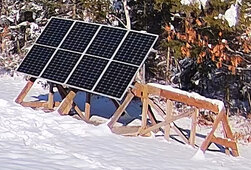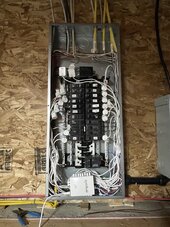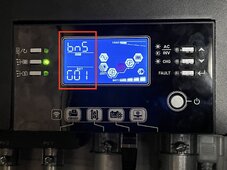I'm hoping that someone can help...
I have a few problems;
I'm SO upset right now!
I was just starting to get to the point where I really use, rely-upon, and enjoy using the system.
But, now I feel like I've been ripped-off with these inverters, given the numerous product problem complaints in this forum and on youtube, and now that there is no new firmware development... that is tantamount to product EOL... now I basically have expensive bricks.
What can I do to resolve these problems, short of replacing the inverters with something all together different and chalking this up to ... I'm just a sucker... don't by budget friendly inverter(s) ?
I don't want an experimental system... I want something that just works. I have enough other things to worry about without adding this to my life-problems list.
System;
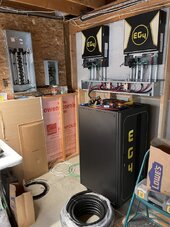
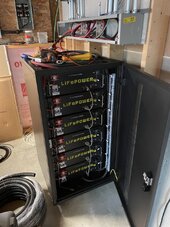

I have a few problems;
- RGB led bar just glows barely visible low intensity red on both units. It did work at one point, and I disabled it, but now won't come back on when enabled.
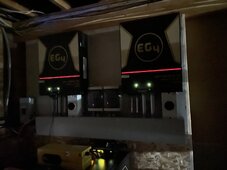
- I have very prominent light flickering when running on Solar-Bat-Utility, wether PV charging or not, but not when running in Utility-Solar-Bat / Solar-Utility-Bat.
- The light flicker is Incandesent bulb, CFL bulb, LED bulb, and LED shop dual T4 form-factor lights... ie.. the type and quality doesn't seem make a difference.
- I don't think I have the bonding screw installed in either inverter, based on lack of continuity from neutral to ground when only powered by battery.... no AC In or AC Out wired connections, and the original as shipped firmware, pre-79.71 ( I've forgotten that version number ).
- I had decided to basically just ignore the flickering as it seemed that no loads stopped working or worked badly other that lights.
- 12/29/2023, I had two spontaneous complete three to five second Load center drop-outs while in Utility-Solar-Bat mode, which I just would not ever expect to happen since the battery pack was 85+% SOC, and PV was nearly non-existent.
- I had been running in USB for the past couple of very cloudy days... I was conserving my battery charge, since I live in Maine and want it for possible Utility outage.
- 12/29/2023, after switching to Solar-Utility-Bat from USB, I commanded mode change to Solar-Bat-Utilty, and the inverters refused to change.
- I tried to make the change by both front panel, and WatchPower iPhone app.
- I was able to sniff the clear-text network traffic and see the WatchPower app request the change, and the inverter "Ack" the request.
- I had to completely power down the system, battery, PV and Utility feed, to re-boot the inverters. Only then, did it switch back to SBU.
- 1/9/2024 - Load center Drop-outs, 3 or more today on SUB.
- There where no high current demands when this happened.... < 1000 watts... just coasting
I'm SO upset right now!
I was just starting to get to the point where I really use, rely-upon, and enjoy using the system.
But, now I feel like I've been ripped-off with these inverters, given the numerous product problem complaints in this forum and on youtube, and now that there is no new firmware development... that is tantamount to product EOL... now I basically have expensive bricks.
What can I do to resolve these problems, short of replacing the inverters with something all together different and chalking this up to ... I'm just a sucker... don't by budget friendly inverter(s) ?
I don't want an experimental system... I want something that just works. I have enough other things to worry about without adding this to my life-problems list.
System;
Purchased - 12/2022
Inverters, panels, batteries
Initial installation of Inverters and batteries - 6/2023



Installation of panels - 10/2023
Load transition from original house load panel center to new inverter load panel center - 11/2023
Added - 12/2023
Eg4 Communications Hub
Chargeverter
- 2- 6500ex
- Manufactured 10/2020, according to the stickers on the side of the units.
- Don't these fall into the unapproved component swap by the assembly service ? that the 79.71 firmware fixes ?
- 240v / split phase config (2P1 & 2P2)
- 79.71 firmware on both units.
- Unit 1 (2P1)
- PV2 - 1 string of 7 panels - roof mount - Tigo TS4-A-O per panel
- Unit 2 (2P2)
- PV1 - 1 string of 6 panels - ground mount - Tigo TS4-A-O per panel
- PV2 - 1 string of 7 panels - roof mount - Tigo TS4-A-O per panel
- Manufactured 10/2020, according to the stickers on the side of the units.
- 1- EG4 Communication Hub
- 1.10 firmware
- 6 - EG4 LiFePower4 batteries
- V3.32 firmware
- 36 - BlueSun Bi-Facial Mono Perc 440w-460w panels
- 20 - deployed
- 14 - planned for summer deployment
- 2 - Tigo TAPs
- 1 - Tigo CCA





